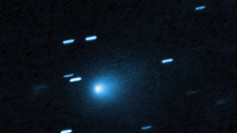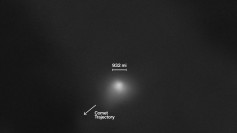NASA has refuted claims that it activated any planetary defense measures after detecting the interstellar object known as 3I/ATLAS, following a viral Spanish-language post that alleged the agency triggered an emergency protocol. The rumor, which spread widely across social media platforms including X and TikTok, has been dismissed by scientists as baseless speculation.
The controversy began when an X user, @HustleBitch_, shared a short video originally broadcast by Mexico's TV Azteca Laguna, captioned in Spanish with the phrase, "Ahora sabemos porque la NASA active el Protocolo de Defensa Planetaria" - translated as, "Now we understand the reason NASA switched on the Planetary Defense Protocol." The post further claimed that "NASA'S WORST FEAR JUST ENTERED OUR SOLAR SYSTEM," describing the object as a glowing, cigar-shaped craft "rotating with precision... structured... intelligent."
The social media frenzy quickly drew millions of views, sparking speculation that NASA had invoked its Planetary Defense Coordination Office (PDCO) - the arm responsible for tracking and mitigating potential asteroid threats. However, reader-added context and independent scientific sources have categorically debunked the story.
According to BBC Sky at Night Magazine, 3I/ATLAS - formally designated as the third interstellar object detected after 'Oumuamua and 2I/Borisov - is "a faint, icy body travelling on a hyperbolic trajectory," not an artificial structure. NASA describes it as a naturally occurring comet passing briefly through the inner solar system before heading back into interstellar space.
NASA's Solar System division has clarified that "the comet clearly originates from outside our solar system and poses no threat to Earth and will remain far away." The object, first detected earlier this year by the Asteroid Terrestrial-impact Last Alert System (ATLAS) program, is under continued observation using the Hubble and James Webb Space Telescopes, which have produced detailed imagery confirming its cometary behavior.
No evidence supports claims that NASA activated the PDCO or any emergency procedures. The agency has issued no alerts, warnings, or official statements regarding 3I/ATLAS, and no documentation exists to suggest a deviation from routine monitoring. The PDCO's mandate focuses on near-Earth objects that could pose a collision risk - criteria 3I/ATLAS does not meet.
Further scrutiny has also revealed that no Spanish or American news outlet has verified the alleged "defense protocol activation." The origin of the story appears to stem from unverified content published on social media, with no corroboration from recognized scientific authorities.
Experts have compared the 3I/ATLAS speculation to the 2017 controversy surrounding 'Oumuamua,' the first known interstellar visitor, which also fueled theories of alien technology due to its elongated shape and unusual motion. Astronomers later determined that 'Oumuamua's trajectory could be explained by natural, non-gravitational forces associated with gas release from its surface - a conclusion that likely applies to 3I/ATLAS as well.



